Understanding Japanese Knotweed :
The Plant that Took Over the World
A Brief History of Japanese Knotweed
Japanese Knotweed, or Fallopia japonica, originally hails from Eastern Asia, specifically Japan, China, and Korea. Its ornamental characteristics and rapid growth made it attractive for Western horticulturists during the 19th century. But little did they realise that this seemingly harmless plant would turn into one of the most invasive species in Europe and North America.
Why is Japanese Knotweed a Concern?
We must understand that while Japanese Knotweed’s rapid growth can be seen as an advantage,

Japanese knotweed taking over a path
this quality is precisely what makes it so invasive. The plant’s aggressive spread can quickly overtake native species, reducing biodiversity. This isn’t just an environmental issue.
Its vigorous rhizomes and roots can penetrate through cracks in concrete, causing structural damage to buildings, roads, and bridges. For property owners, the presence of Japanese Knotweed can lead to decreased property values and potential legal issues.
Identifying Japanese Knotweed
We must be able to identify Japanese Knotweed, especially if we own land or are in the property business. This plant can grow up to 3-4 meters in height during its peak season. It has:
- Bamboo-like stems: Hollow and reddish-brown, becoming brittle in winter.

Japanese knotweed canes
- Heart-shaped leaves: Bright green and up to 14cm long.

Heart-shaped leaves
Clusters of cream flowers appear small between late summer and early autumn.

Japanese Knotweed flowers
The Lifecycle of Japanese Knotweed
Understanding the lifecycle of Japanese knotweed allows us to take timely measures to manage it. The plant emerges in early spring and increases throughout the summer. The plant flowers provide an easy identification window from late summer to early autumn. Come winter, the plant dies back to ground level, but its underground rhizomes remain active, storing energy for the next growth cycle.

crown
Managing and Controlling Japanese Knotweed
We’ve established that Japanese Knotweed is invasive and potentially damaging. However, all is not lost. There are several ways we can manage and control its spread:
Physical removal:
This involves excavating the plant along with its extensive root system. It’s labour-intensive and needs to be done meticulously to ensure no remnants are left behind.
Chemical treatment:
Using herbicides like glyphosate can be effective. However, multiple treatments are often required over several years. Following the guidelines is crucial to avoid harming native plants or water sources.
Biological control:
Certain insects, like the Japanese Knotweed psyllid, feed on the plant and can act as a control method. However, introducing a new species can have other ecological impacts, so this method is still under research and not widely adopted.
Legislation and Japanese Knotweed
Many countries have recognised Japanese Knotweed’s threat and enacted laws and regulations to control its spread. We must know these regulations, especially in the property or construction sectors. In the UK, for instance, it’s illegal to plant or cause Japanese Knotweed to grow in the wild.
The Economic Impact of Japanese Knotweed
We cannot ignore the economic repercussions of Japanese Knotweed. The cost of managing and eradicating Japanese Knotweed runs into millions yearly for many countries. For property developers and homeowners, the presence of the plant can result in legal battles, repair costs, and decreased property values.
The Lifecycle of Japanese Knotweed
Understanding the lifecycle of Japanese knotweed allows us to take timely measures to manage it. The plant emerges in early spring and increases throughout the summer. The plant flowers provide an easy identification window from late summer to early autumn. Come winter, the plant dies back to ground level, but its underground rhizomes remain active, storing energy for the next growth cycle.
Managing and Controlling Japanese Knotweed
We’ve established that Japanese Knotweed is invasive and potentially damaging. However, all is not lost. There are several ways we can manage and control its spread:
Physical removal:
This involves excavating the plant along with its extensive root system. It’s labour-intensive and needs to be done meticulously to ensure no remnants are left behind.
Chemical treatment:
Using herbicides like glyphosate can be effective. However, multiple treatments are often required over several years. Following the guidelines is crucial to avoid harming native plants or water sources.
Biological control:
Certain insects, like the Knotweed psyllid, feed on the plant and can act as a control method. However, introducing a new species can have other ecological impacts, so this method is still under research and not widely adopted.
Legislation and Japanese Knotweed
Many countries have recognised the threat of Knotweed and have enacted laws and regulations to control its spread. We must know these regulations, especially in the property or construction sectors. In the UK, for instance, it’s illegal to plant or cause Japanese Knotweed to grow in the wild.
The Economic Impact of Japanese Knotweed
We cannot ignore the economic repercussions of Knotweed. The cost of managing and eradicating Knotweed runs into millions yearly for many countries. For property developers and homeowners, the presence of the plant can result in legal battles, repair costs, and decreased property values.
Knotweed is more than just a plant. It’s a symbol of the unintended consequences that can arise from moving species across continents. While its ornamental appeal is undeniable, the challenges it presents are significant. We can control its spread and mitigate its impacts through understanding, early detection, and rigorous management techniques,
Inform your mortgage lender about the presence of the plants
as it can impact the value of your property and make it difficult to secure a mortgage. Some mortgage lenders may require a specialist survey to be carried out and a management plan to be in place before they lend on a property affected by knotweed.
The cost of managing knotweed can vary depending on the extent of the infestation and the property’s location. However, engaging a professional specialist company to complete the treatment program is essential. DIY methods are unlikely effective and may even spread the plant further.
In many cases, it may be possible to sell a property with this invasive weed.
The plant must be managed effectively, and the buyer must be informed about its presence. The sale of a property with Japanese knotweed is subject to specific legislation, including the Environmental Protection Act 1990, which requires the seller to disclose the plant’s presence.
To summarise, Japanese knotweed is a highly invasive plant species that may cause significant damage to buildings and structures. It can impact the value of a property. It is essential to identify the plant and seek professional advice from a specialist company to manage the infestation effectively. The cost of managing knotweed can vary. You should engage an experienced specialist to carry out the treatment program. Informing your mortgage lender and potential buyers about the presence of the plant is also crucial. It could reduce the value of your property and make it difficult to secure a mortgage. So, it is possible to manage Japanese knotweed and protect your property from the damaging effects of this invasive plant.
